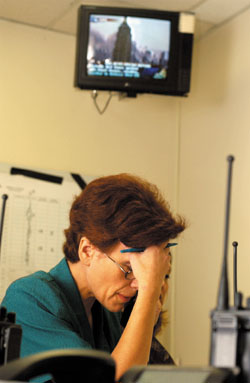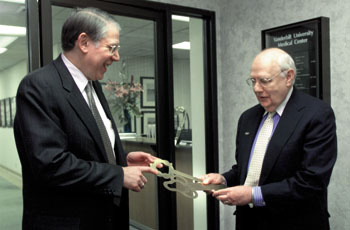
Susan Johnson talks on the phone in the VUMC emergency operation center on Sept. 11. (photo by Dana Johnson)

Dean Steve Gabbe received the keys to the medical students and faculty from Dean John E. Chapman in March. Chapman, who is now associate vice chancellor for Medical Alumni Affairs, was honored in April at a black-tie gala attended by more than 1,000 people. (photo by Dana Johnson)

An artist’s rendering of the Bill Wilkerson Center.

An artist’s rendering of the new Monroe Carell Jr. Children’s Hospital.
The past year was tumultuous for news and world events. The staff of the Reporter examined the top Vanderbilt University Medical Center stories of the year, which are recapped here in no particular order.
Prepared for attack
When the magnitude of Sept. 11 terrorist attacks on the World Trade Center and Pentagon became evident, VUMC officials were ready to aid victims if called upon.
As staff, faculty, students, and others gathered throughout VUMC to follow the unbelievable events unfolding on live television, the Medical Center opened its emergency operation center to coordinate efforts and assess institutional readiness to assist victims of the plane crashes and building destructions in New York, Washington, D.C., and Pennsylvania.
The institution was officially on Yellow Alert status, indicating a state of preparedness for mass casualty, from shortly after the attacks on Sept. 11 until about 10 a.m. on Sept. 12, when the Office of Emergency Management notified VUMC that it was unlikely any casualties would be airlifted to the hospital.
Although no casualties were brought to Vanderbilt, Burn Unit nurses Wendy Beese and Sharron Craven, and Carol Etherington with the School of Nursing went to New York City to help cover nursing shifts at area hospitals.
VUSM ranks 16th in nation
Vanderbilt University Medical School ranked 16th out of 125 accredited medical schools in the United States, ahead of Case Western Reserve University, University of Chicago, and Northwestern University in the 2001 U.S. News & World Report.
Sepsis drug tested
After six years of research here, VUMC became an international clinical coordinating center for the first drug proven to reduce deaths due to sepsis, an infection process that claims more than 250,000 lives a year in the United States alone.
As reported in The New England Journal of Medicine, in clinical trials that concluded in June 2000, the drug, Zovant TM, (recombinant human activated protein C), was shown to reduce overall mortality by almost 20 percent. The study, sponsored by APC manufacturer Ely Lilly, was conducted at Vanderbilt and 163 other medical centers in 11 countries.
St. John’s Wort not effective: study
The first large-scale, multi-center trial in the United States of the effectiveness of St. John’s Wort in treating moderately to severely depressed individuals indicated that the herbal remedy is not effective.
Results of the double-blind, placebo-controlled study, led by Dr. Richard C. Shelton, professor of Psychiatry at VUMC, were published in The Journal of the American Medical Association.
Wilkerson Center approved
In September, the Executive Committee of the Board of Trust approved the $61 million Vanderbilt Bill Wilkerson Center for Otolaryngology and Communication Sciences and Musculoskeletal Institute.
Construction of the eight-story building, atop the hospital parking garage between the Oxford House and Medical Center East on 21st Avenue South, began this fall and is expected to be completed in 2003.
Vanderbilt among best in nation
A national survey, released by U.S. News and World Report, continued to recognize Vanderbilt University Medical Center among the nation’s “stellar” health care providers.
In the 12th annual assessment called “America’s Best Hospitals,” Vanderbilt University Hospital and the Vanderbilt Clinic were recognized among the nation’s best in 11 of the 17 specialty areas surveyed.
The medical center was also named one of the best medical centers in the United States by Best Doctors Premier Hospital Networks. Vanderbilt was chosen out of the field of 5,000 based on its high concentration of top doctors, services for international patients and dedication to excellence.
Fetal procedure first in United States
In July, Dr. Joseph Bruner and Dr. Erin Harley performed the first fetal amniotic exchange in the United States for gastroschisis, and one of a handful performed in the world. The fetus was diagnosed with gastroschisis, a developmental abnormality that causes the intestines to poke through a weakness in the abdominal wall and into the mother’s uterus, where the amniotic fluid was becoming increasingly concentrated with urine and toxic to the delicate internal organs turned outward.
Diabetes Center announced
The Vanderbilt Diabetes Center marked more than a quarter century of discovery, training, and patient care with a daylong scientific symposium and the announcement of a bold new initiative—the planned creation of the Vanderbilt Comprehensive Diabetes Care Center.
Dr. Harry R. Jacobson, vice chancellor for Health Affairs, made the announcement at a celebration dinner in November.
Meharry,Vanderbilt train genetic scientists
A group of researchers at Meharry Medical College and VUMC, recognizing that the education of genetic scientists must change to meet the challenges of the rapidly expanding field, was awarded $750,000 to fund an innovative trans-institutional genetics research training program. The award, from the National Institutes of Health and the National Institute of General Medical Sciences, supports two years of graduate study for each of eight students.
Brain Institute launched
The Vanderbilt Brain Institute was officially launched in October at a lecture by the Dr. Steven E. Hyman, director of the National Insitute of Mental Health. “Vanderbilt has committed its highest level of support to discovery in neuroscience,” Jacobson said in his welcoming remarks. “We work together across the University to find answers to the secrets of the brain, working at the level of molecules, cells, circuits, and living beings.”
Possible Parkinson’s link found
The first study to search the entire human genome for regions linked to Parkinson’s disease has found evidence that multiple genes may contribute to development of the disease. The findings, reported by a multi-center team including Vanderbilt’s Program in Human Genetics in November, will accelerate further studies of causes and potential treatments for this devastating disease.
VCH outpatient clinic announced
The Vanderbilt Board of Trust approved Phase II of the Monroe Carell Jr. Children’s Hospital, allowing for construction of an 11-story outpatient clinic. The $20 million outpatient clinic will be built parallel to the new children’s hospital, which is currently under construction.
Buerhaus predicts nursing shortage
Peter I. Buerhaus, Ph.D., Valere Potter Professor of Nursing and senior associate dean for Research at VUSN, published a study in The Journal of the American Medical Association indicating that the health care industry will suffer a severe nursing shortage in the next 10 to 20 years.
Genomics conference held
The inaugural Vanderbilt University Conference on Genomics, titled “Neurogenomics: Building a Better Brain,” was held in May and featured research advances at the crossroads of neuroscience and genomics. Attended by 160 participants, the scientific sessions spanned four days and explored the genes underlying brain development, neuronal plasticity, drug action, and psychiatric diseases in human and animal model systems.













